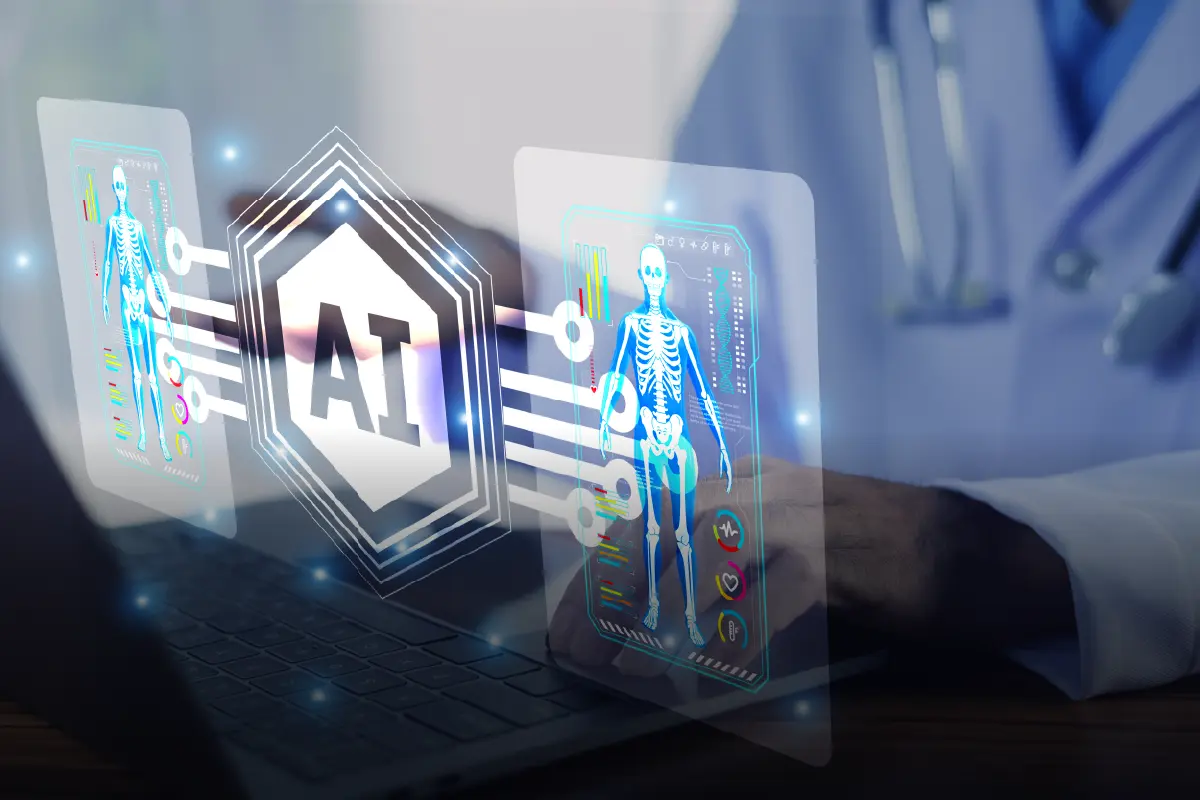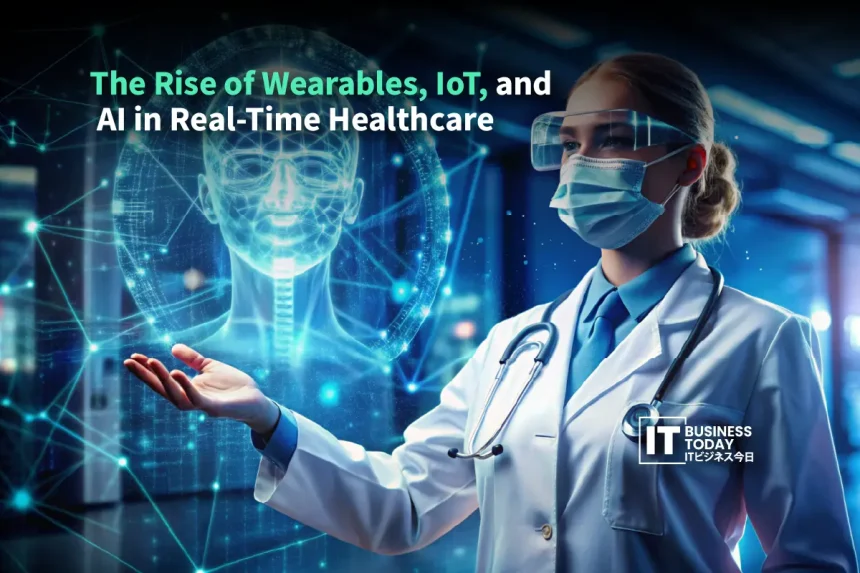Healthcare used to be simple. You felt sick. You went to a doctor. You waited. Got treatment. That was it. Most of the time, problems were caught late. Doctors worked with snapshots. Patients acted after symptoms appeared. That is the old way. It is changing fast.
Now, wearables, IoT devices, and AI are coming together. Wearables collect data every day. IoT connects it all. AI makes sense of it. Suddenly, healthcare is continuous. Doctors can see trends before things get serious. Patients can act early. Interventions happen before emergencies. This is real-time healthcare. Not theory, not far in the future. It is happening now.
This article looks at how this convergence works. How it improves chronic care, remote monitoring, predictive analytics. The challenges, like security, interoperability, and bias. Plus, the future is going to be very interesting with hyper-personalization and digital twins. Besides, the concept of real-time healthcare is revolutionizing our lives, the way we care for others and even the way we perceive health.
Also Read: How Japan’s Next-Gen Supercomputing Push Is Powering a New Wave of Enterprise Innovation
Building the Foundation of Real-Time Healthcare
Real-time healthcare is becoming real. Not tomorrow, not in some sci-fi future, it is happening now. At the core, there are three things working together. Wearables, IoMT, and AI. Each has its own role, but together they change everything. Wearables are not just fitness bands anymore. Think medical-grade ECG patches or continuous glucose monitors. They collect data continuously, not just when you see a doctor. That data is precise. It shows what is happening in your body over hours, days, weeks. Doctors can finally see trends instead of snapshots. Patients can see patterns too.
Then there is the Internet of Medical Things. It connects all these devices. It makes sure the data flows from your wearable to the cloud, to your doctor’s system, wherever it needs to go. This is not some one-time upload. It is constant. You do not have to wait for appointments. Your doctor can see your vitals today, right now. They can spot problems early. It also supports research. Large studies can use this constant data, not just clinic visits. The network is secure. The data is safe. It works even at scale.
AI comes in last but is the glue. It takes all that data and makes sense of it. Raw streams are messy, overwhelming. AI looks at patterns, highlights what matters, warns of issues before symptoms appear. Google published its first Health Impact Report in 2025. It shows how their technology and partnerships are already improving care in several areas. These three together. This is real-time healthcare. Proactive. Connected. Intelligent. Patients and doctors finally have the tools to act before it is too late.
Transforming Remote Patient Monitoring and Chronic Care
Remote patient monitoring is happening everywhere now. Not in the future. Not in papers. At home, at clinics, even in your pocket. Chronic diseases like heart failure or diabetes always needed attention. But doctors only saw snapshots. Once every few months. Now devices like smart scales, blood pressure cuffs, and ECG patches collect data all the time. Every day, every hour, sometimes minute by minute. That data goes to the cloud. Doctors see it. Interventions happen before a crisis. Weight goes up, blood pressure spikes, heart rhythm changes. Doctors notice it early. Patients notice it. Problems get caught before they get serious. This is real-time healthcare working.
Patients start acting differently too. Seeing your own numbers every day changes things. You take your medication on time. You move more. You eat a bit better. Even small alerts from an app or wearable make a difference. Feedback is constant. Quiet. It helps people feel connected. Not just waiting for the next appointment. Over time habits change. Outcomes improve. Risks drop. Simple. Real. Effective.
Research is changing too. Clinical trials used to be visits, waiting, limited data. Now people join from home. Devices track vitals continuously. Data goes to researchers securely. Apple Health shows how big this can get. Join over 350,000 people contributing to groundbreaking research studies by sharing health data with the Apple Research App. Hundreds of thousands of people giving real-time insight. Makes trials faster, better, more inclusive. Treatments reach patients faster. Feedback is immediate. Decisions happen sooner. Real-time healthcare is not some idea. It is here. It is practical. It saves time. Improves care. Keeps people healthier. Action happens before problems get serious. Every single day.
The Predictive Power of AI in Healthcare

AI is changing how medicine works. It is moving care from reacting to problems to spotting them before they happen. Subtle things matter now. Small changes in sleep, small changes in heart rate. They can signal an infection or deterioration days before anyone would notice. Doctors can see these patterns. Patients can get help earlier. This is predictive analytics in real-time healthcare. It is not guesswork. It is data working for people. Professionals are noticing it too.
Clinical decision support is part of the picture. AI models sift through tons of data. They tell doctors what needs attention. Alerts come in real-time. They help with decisions. Too many alerts can overwhelm doctors. Alert fatigue is real. Smarter AI now is context-aware. It knows what is important and what can wait. That makes decision-making faster and safer. Doctors can focus on patients instead of getting lost in numbers.
Early disease detection is becoming possible. AI can look at retinal scans, speech patterns, or other IoMT-collected data. Tiny changes show the earliest signs of diseases like neurodegeneration. Patients get help before major symptoms appear. Hospitals and researchers see the benefits too. McKinsey reports that 85% of healthcare leaders are exploring or using Gen AI now. That is massive adoption. Everyone is realizing that AI is not the future anymore. It is here. It helps catch problems early, guides doctors in real-time, and gives patients a chance to act before it is too late. Real-time healthcare powered by AI is practical, powerful, and increasingly trusted.
Navigating the Interoperability, Security, and Ethics Maze

Real-time healthcare is powerful but messy. The technology is operational, data is moving smoothly, yet the systems are not always synchronized. Wearables, IoMT devices, and EHRs communicate in their own distinct ways. Proprietary formats, different standards. Merging them is hard. Doctors want a complete picture. Patients want seamless care. But data silos block it. Fixing this is not just technical. It is organizational, cultural, and sometimes political. Everyone has to work together. Standards help, but adoption is slow.
Security is another giant problem. Health data is extremely sensitive. Continuous monitoring collects intimate details day and night. Protecting it is huge responsibility. HIPAA in the US, GDPR in Europe. Breaches can ruin trust instantly. Companies build firewalls, encryption, monitoring. But attacks evolve. Every system has weak spots. Patients, doctors, regulators all watch closely. One mistake and confidence drops. This is a real challenge for real-time healthcare.
Equity and fairness matter too. AI learns from data. If the data is biased, the AI is biased. It can miss symptoms in some groups, give wrong alerts, worsen inequalities. Training models on diverse populations is critical. That is how trust grows. That is how care improves. It is a no-brainer for the leaders that this is the top commitment. According to Deloitte research, in 2025, more than 70% of C-suite executives from five countries will still mention improving operational efficiencies and productivity gains as their major focuses. Operational Efficiency, Trust, Fairness, Security. They all link. Without addressing these, the power of real-time healthcare is limited. Solving these problems is hard but necessary. This is the maze. It is real. And it is worth navigating.
The Road Ahead
Real-time healthcare is changing things fast. Continuous data from wearables, IoMT devices, and AI does not just give snapshots. It builds a picture of health every day. Chronic care is improving because doctors and patients can see trends early. Problems are caught before they become emergencies. People act sooner. Outcomes get better. The system works faster. This is real. It is happening now.
Looking ahead, two big trends stand out. Hyper-personalization is coming. The idea of a Digital Twin, a digital version of a person, could make care truly personal. Behavioral data and genomic information combined with IoMT devices will make predictions smarter. Interventions will be more precise.
But this cannot happen alone. Collaboration among tech companies, doctors, hospitals, and regulators is a must. The development of policies, standards, and innovations should take place simultaneously. Only then the complete potential of real-time healthcare can be realized. The potential is huge. The need is urgent. The time to act is now.







